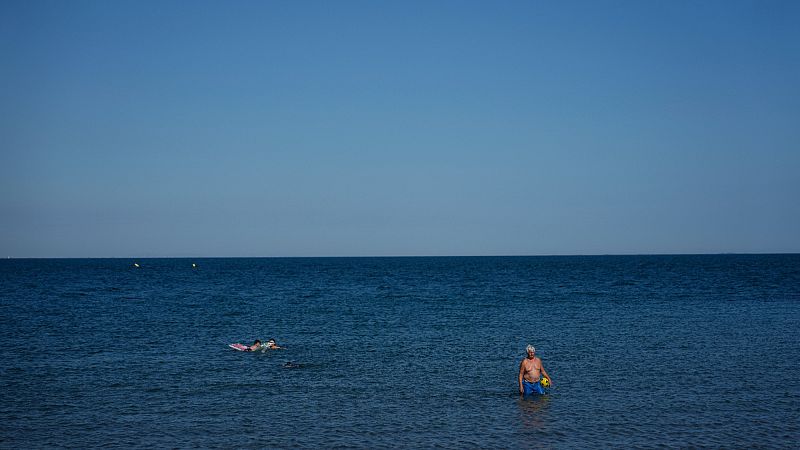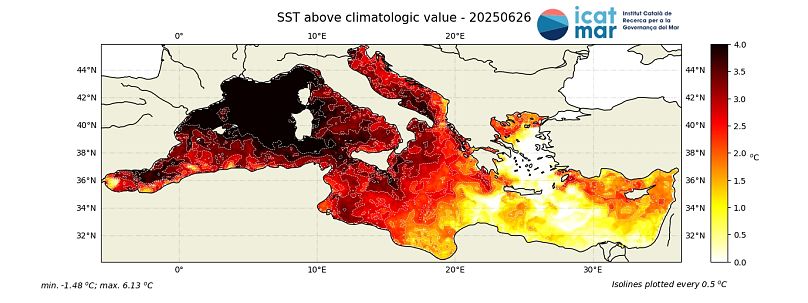
Sea surface temperatures in the Mediterranean have reached their highest level ever recorded for June.
On 29 June, sea surface temperatures hit 26.01°C, according to data collected by Copernicus and analysed by Météo-France. Overall temperatures are currently 3°C higher than average, with spikes exceeding 4°C in some places around the French and Spanish coasts.
The most intense warming was observed in the western Mediterranean basin, including the Balearic Sea and the Tyrrhenian Sea. With the current weather conditions, scientists say temperatures are unlikely to drop anytime soon.
The Mediterranean is considered one of the world’s most vulnerable ‘climate change hotspots’, warming much faster than the global average. Without action to curb climate change, experts warn that persistent marine heatwaves - prolonged periods of abnormally high ocean temperatures - could change the region beyond recognition.
Marine heatwaves could devastate life in the Mediterranean Sea
A persistent and growing marine heatwave is gripping the region, with “severe” and “extreme” conditions emerging off southeastern Spain and northern Morocco.
Marine scientists warn that the unfolding situation could bring devastating impacts for biodiversity, fisheries, aquaculture, and even weather patterns across southern Europe and North Africa.
“Marine heatwaves of this magnitude in the Mediterranean Sea have had major effects on marine life,” says Dr Kathryn Smith from the Marine Biological Association of the UK.
“In the past, we have seen impacts like mass mortalities of invertebrate species, die-offs of seagrass beds and disease outbreaks in mussel farms. It's likely that we'll see similar impacts from this event.”

These events have already driven coral populations down by 90 per cent and pushed the noble fan mussel to the brink of extinction.
Warmer waters hold less oxygen, leading to mass fish die-offs such as those seen in Tuscany in 2024. And, as fish dive deeper to escape the heat on the surface, they can’t be reached by seabirds, which then die off in their masses, too.
The ripple effects of marine heatwaves extend onto land, too. Warm seas fuel extreme weather, as seen during Storm Daniel in 2023 which killed nearly 6,000 people. It was made 50 times more likely and 50 per cent more intense by high sea surface temperatures in the Mediterranean.
Floods in Valencia in 2024, which claimed over 200 lives, have also been linked in part to high sea surface temperatures.
Marine heatwaves are becoming more intense and lasting longer
Marine heatwaves are now ten times more intense than in pre-industrial times and last three times as long.
“Climate change is responsible for the global increase in the frequency, duration and intensity of marine heatwaves,” says Dr Alistair Hobday, research director for the Commonwealth Scientific and Industrial Research Organisation’s (CSIRO) Sustainable Marine Futures Programme.
The Mediterranean Sea has been steadily warming since the 1980s, with a sharp acceleration over the past decade. Over the last 40 years, it has gone from experiencing one marine heatwave per year in defined areas to an average of four per year, which cover almost the entire sea. Temperatures have been constantly above average for the past five years.
“The unfolding, wide-reaching heatwave in the western Mediterranean now demands close attention,” says Dr Karina von Schuckmann, a senior advisor at Mercator Ocean International.
Scientists stress that only rapid global emission cuts can halt this trend. Without urgent action, this climate hotspot could be permanently transformed.







